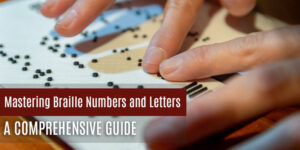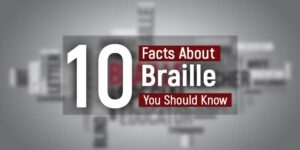Accessibility and communication are essential aspects of our society, allowing individuals to access information and express themselves effectively.
Two seemingly distinct systems, braille and sheet music, play vital roles in facilitating these processes for people with visual impairments.
While Braille provides blind individuals with a means to read and write, sheet music allows musicians to perform compositions accurately.
Despite their different purposes, braille and sheet music share surprising similarities in their usage, notation systems, and impact on individuals with visual impairments.
Understanding Braille
It is a system of raised dots that enables blind individuals to read and write. Developed by Louis Braille in the early 19th century, it revolutionized communication for the visually impaired.
The braille system consists of combinations of six raised dots arranged in 2 columns of three dots each.
By feeling these dots with their fingertips, blind individuals can perceive letters, numbers, punctuation marks, and even musical notation.
Braille allows them to independently access books, magazines, educational materials, and personal correspondence, empowering them to participate fully in society.
Braille Music Sheet
Braille Music Sheet is the written representation of musical notation that visually guides musicians when performing compositions accurately.
Sheet music provides detailed instructions on pitch, rhythm, dynamics and other musical elements that facilitate consistent performances across musicians and settings. It acts as an intermediary between the composer’s intent and the musician’s interpretation, creating seamless performances across performances and environments.
What are the similarities between Braille and Sheet Music Braille?
Both systems rely on the notation to convey meaning to things; Braille uses raised dots, while sheet music uses symbols and musical notation marks as its notation system.
Braille and sheet music both employ universal symbols and patterns that ensure universal understanding among blind readers. Braille’s system utilizes standardized symbols that ensure consistent interpretation among readers who cannot see.
Sheet music employs musical symbols that are universally understood by musicians – notes and dynamics are widely recognized – to facilitate efficient communication.
Braille and sheet music each play an essential role in accessibility. Braille provides blind individuals with equal access to written materials like books, educational materials, and personal correspondence.
Sheet music also empowers musicians with visual impairments to perform compositions accurately, broadening their artistic and professional growth opportunities.
Braille literacy provides blind individuals with the means of reading and writing in Braille, opening up endless intellectual, personal and educational possibilities.
While braille and sheet music share certain similarities, each has unique characteristics.
While braille and sheet music share commonalities, they also possess distinct characteristics. Braille primarily serves an informational purpose, providing access to written texts. In contrast, sheet music serves an expressive purpose, guiding musicians in interpreting and performing compositions.
Braille focuses on conveying meaning through the arrangement of dots, while sheet music aims to communicate the musical nuances and emotions expressed in a composition.
Another difference lies in the complexity of their notation systems. Braille’s tactile system consists of different combinations of raised dots, which blind individuals must learn to decipher.
Conversely, sheet music’s notation system encompasses a wide range of musical symbols, including notes, rests, key signatures, time signatures, dynamics, and more. Musicians must understand and interpret these symbols to accurately perform a piece of music.
Moreover, the learning processes for braille and sheet music differ. Learning Braille requires individuals to develop tactile sensitivity and spatial understanding of the dot patterns.
Mastering sheet music involves acquiring music theory knowledge, reading musical symbols, and translating them into physical actions on an instrument. Both learning journeys present unique challenges, but they ultimately provide individuals with valuable skills that enhance their abilities and open new horizons.
The impact of braille and sheet music.
Braille music sheet’s impact on those with visual impairments is enormously profound.
Braille allows blind individuals to independently access literature, education and information sources, which contributes greatly to intellectual growth and educational opportunities.
Sheet music offers musicians with visual impairments an avenue for artistic expression and professional growth.
Sheet music empowers musicians to perform compositions accurately, collaborate with fellow musicians, and pursue careers in music. Sheet music transcends visual limitations to enable musicians to share their talents and passion with audiences around the globe.
Braille and sheet music hold immense emotional and cultural importance for individuals living with disability. Braille allows blind individuals to engage with literature, preserving the joy of reading while cultivating storytelling. Sheet music preserves musical compositions for future generations while upholding cultural heritage and contributing to human expression.
Conclusion
Braille and sheet music both provide significant support to individuals living with visual impairments, with distinct yet striking similarities in how they’re used and impactfulness for them.
Both Braille and sheet music rely on notation to communicate meaning and improve accessibility, with Braille using notation to give access to written information, while sheet music focuses on artistic expression and performance.
As a society, it is vital that we support and promote braille literacy and the preservation of sheet music to ensure inclusiveness, accessibility and the celebration of human creativity. From sheet music transcriptions to Braille music instruction, we offer tailored solutions to enhance your musical experience.







